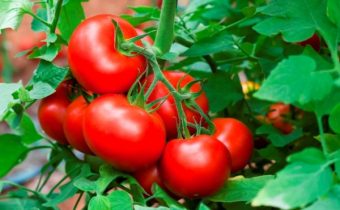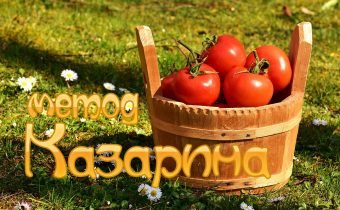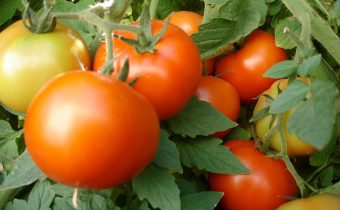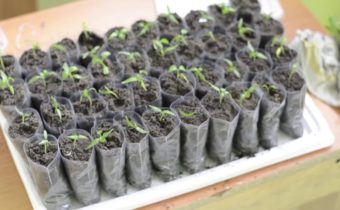Tomato variety "Spasskaya Tower F1", yield, photos and reviews
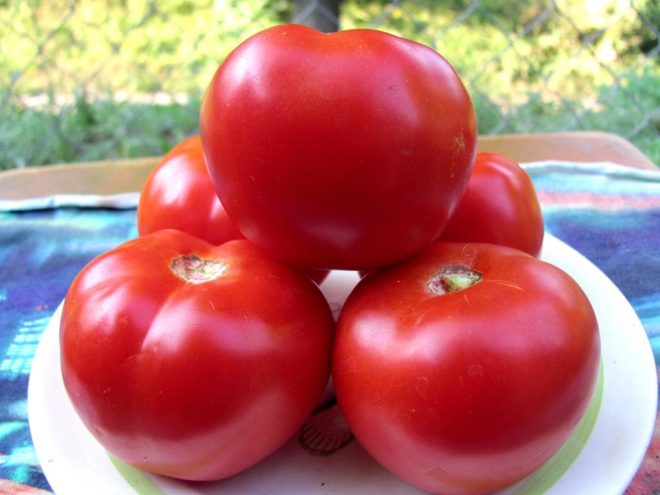
Back in 2015, Chelyabinsk breeders offered a whole group of hybrids, among which a special place is occupied by the tomato “Spasskaya Tower F1”, a unique, according to the reviews of already familiar with it, vegetable growers, resistant to bad weather hybrid.
general information
The variety is medium early, rather tall - up to 150 cm. It refers to the so-called pepper tomatoes - in the process of plant growth up to 6 brushes are formed, on each of which there are 5-6 fruits. In total for a season from 1 square meter it is possible to remove up to 30 kg of bright rounded tomatoes.
This hybrid, which appeared only two years ago, has already gained popularity: the Spasskaya Tower F1 tomato is universal, and according to reviews of vegetable growers and photos of fruit-bearing plants, it has a high yield.
The fruits in the hands ripen amicably, which allows us to eat them simultaneously. Tomatoes retain good appearance and taste for a long time. Get acquainted with tomato “Spasskaya Tower F1” tomato, its characteristics and description of the variety.
Hybrid Characteristics
- The hybrid is intended for cultivation as in a protected, and open ground, on terms of ripening belongs to group of mid-early tomatoes. Since it was developed under the conditions of risky farming, it suffers temporary positive drops in temperature and some shading.
- The plant belongs to the determinant, that is, the growth of the stem is limited - about 150 cm in protected ground and about 100 cm in the open, and stops after the formation of ovaries. Bushes are not prone to thickening, form a small number of stepsons.
- Fruit ripening is fairly amicable and abundant, therefore the presence of supports is required and the garter of stems and individual brushes, which can break under the weight of a tomato, is required.
- The fruits of tomato are smooth, have a rounded, slightly elongated shape, the color is bright red with a pink tinge. The weight of the fruit in the hands is smooth, mostly about 200g. The tomato is not prone to cracking, has a dense skin, is well stored and without loss is transported.
- Tomatoes “Spasskaya Tower F1”, according to reviews of gardeners, have excellent taste and dense flesh, suitable for fresh use and for preservation - for salting, cooking ketchup, lecho, and tomato paste.
- The tomato tolerates fluctuations in temperature, shade, and is resistant to most fungal diseases, such as cladosporia, TMV, gall nematode, and others.
See also:Tomato pear "Tlakolula", characteristic and description
The advantages and disadvantages of the variety
The brightest qualities of the variety appear when growing a tomato in a greenhouse, however, its use is also justified in the open field, here are its main features: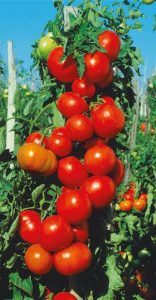
- Resistance to temperature changes (except for frosts) and shading.
- Unique yield.
- Wonderful taste.
- Resistance to diseases of tomatoes.
- Does not require much time for thinning the leaves and removing the stepsons.
- Maintains long storage and transportation.
- Versatile in use.
The disadvantages of the variety must include binding the main stem and arms to prevent breaking them under the weight of ripening fruits.
Features of growing
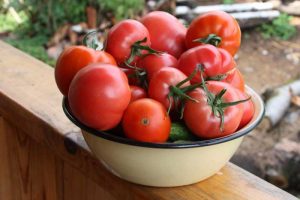 To obtain a high-quality crop of tomatoes, summer residents pay special attention to the preparation of seeds. If there is no information on seed treatment on tomato seed bags, presowing treatment is carried out, which includes:
To obtain a high-quality crop of tomatoes, summer residents pay special attention to the preparation of seeds. If there is no information on seed treatment on tomato seed bags, presowing treatment is carried out, which includes:
- Soak in a weak solution of potassium permanganate.
- Treatment with growth promoters.
Land preparation
Land for planting seedlings usually prepared in the fall. Used garden or sod land with the addition of compost and ash. If the land is clayey, add sand or peat for looseness.
Important!
It is not recommended to use the land used for planting potatoes and tomatoes for planting seeds. Well fit land on which the cabbage was grown.
Tomatoes prefer loose and fertilized soils, however, fresh or un-retained manure should not be allowed.
If you are not sure of the quality of the land for planting, conduct its disinfection by roasting in the oven or freezing in the street in the cold.
Sowing seeds

Tomato seeds “Spasskaya Tower F1” are sown in seedling boxes in the first half of March, so that by the time of planting in the greenhouse or under the film, it has 5-6 true leaves and a strong stalk.
The ground in the prepared boxes is moistened, seeds are sown with an interval of 15-20 mm, lightly sprinkled with earth and a little compacted above by hands.
Tip!
After planting, it is advisable to keep the boxes in a warm (22-25 degrees) place before the emergence of shoots, covered with plastic wrap. When the first shoots appear, the film is removed, the drawers are exposed to the most lighted place in the room, in order to avoid pulling them out.
When growing seedlings is recommended:
- Water very carefully, do not overwet the soil.
- If necessary, on cloudy days add artificial lighting.
- Monitor the temperature in the room.
For hardening seedlings, you can periodically take it to cool rooms. Grown up seedlings with two true leaves are swooping into larger boxes or peat pots. In a week, you can feed it with a special mineral fertilizer for seedlings.
See also:Description of the characteristics of tomatoes "Cosmonaut Volkov"
Landing seedling "Spassky Tower F1"
Tomatoes are planted in the greenhouse with the onset of stable heat. By the time of disembarkation, it has healthy leaves, a strong trunk and a strong root system.
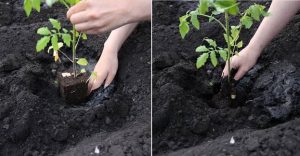
For growing tomatoes and growing seedlings, the greenhouse is usually prepared in autumn:
- Disinfect walls and all auxiliary elements of the greenhouse.
- On acidic soils make lime or dolomite flour.
- Make mineral fertilizers and compost
- They make warm beds.
- Sow sidderaty.
Many summer residents, in case of spring frosts, install additional small arcs in the greenhouse, and, if necessary, cover young plants with an additional blanket of any auxiliary breathable materials. After the threat of frost passes, the arcs are successfully removed so as not to interfere with the growth of tomatoes.
Usually by the end of May, when the threat of frost is gone, the seedlings are separated - some are planted in open ground, some are left in the greenhouse. Plants are located at a distance of about 50 cm from each other.
How to care for a tomato
Tomato is a plant that is demanding to the composition of the soil, likes a well-hydrated and loose earth, while it reacts very badly to the increased humidity of the air.
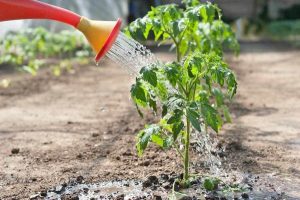
When caring for tomatoes, carry out the following work:
- Top dressing with mineral fertilizers - 3-4 during the growing season and top dressing with green manure (fermented herb extract).
- Watering, depending on the weather, but at least 1 time in ten days in the absence of rain and only at the root.
- Regular weeding and loosening the soil.
- Grown up plants, and in open ground they grow up to 1 m, tied to supports.
- When the plant is thickened, carefully cut off unnecessary leaves or stepchildren.
Important!
Fertilizing mineral or other fertilizers is recommended only after watering or rain.
In the process of growing tomatoes constantly monitor the development of the plant, so that if necessary, take during the measures.
The lack of nutrients can be determined by the following external features: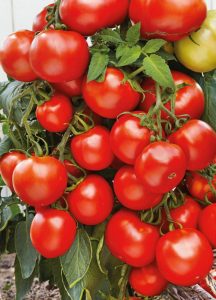
- With an insufficient amount of potassium in the soil, the growing leaves coagulate, and the old leaves turn yellow and dry.
- The lack of zinc is manifested in the appearance of brown spots on the leaves and twisting the leaves up.
- With a lack of nitrogen, the leaves gradually turn yellow, the bush is drawn out, the growth of the plant slows down.
- The lack of sulfur is manifested by signs similar to nitrogen starvation, but at the same time the young leaves turn yellow. The stem becomes brittle.
- With a copper deficiency in the soil, the plants change greatly, become lethargic, the leaves curl into tubes. The plant sheds flowers without forming ovaries.
- Phosphorus deficiency gives the leaves a purple color. They start spinning inside.
- With a lack of calcium, the tips on the fruits gradually rot.
If you notice these signs in time and take action, feed them with appropriate fertilizers and micronutrients, the plants will thank you.
Features care for tomato in the greenhouse
Using greenhouses for growing tomatoes usually allows you to achieve higher yields due to comfortable plant conditions.
Watering tomatoes in the greenhouse should be carried out directly under the root. In sunny weather, water droplets falling on the leaves can cause burns.

To avoid increasing air humidity, the following techniques are used in greenhouses:
- Use drip irrigation or watering in separate inverted containers directly near the plants (so that moisture gets directly to the roots).
- Mulch the soil with any covering material or mowed grass, which gives plants additional nutrition during decomposition. Yellowed or old tomato leaves should not be used for mulching.
- Use the vents to maintain low humidity in the greenhouse, trying to avoid drafts - tomatoes do not like them.
A tomato in a greenhouse grows up to 150 cm, and, despite the fact that there are not very many stepsons, it still requires control over the thickening. Remove unnecessary leaves and stepchildren in the morning, so that during the day the sections are dried out and not rotted. When removing the leaves, we must not forget that the leaves are one of the ways to feed the plants through photosynthesis; therefore, it is impossible to abuse their removal, to bare the plants.
Variety refers to a squash tomato. The fruits are round, slightly oval, weighing from 200 to 500g, arranged in brushes of 5-6 pieces and ripen almost simultaneously. If you want to remove the fruit with brushes, you need to provide strong supports and mounts, both stems and each brush. For the garter is convenient to use coarse plastic nets.
Lustar tomatoes recently represent the interest of growers and for commercial purposes, as they have a higher cost on the market. For tomatoes of this variety, in addition to excellent taste, good keeping quality is characteristic - up to 25 days and stability during transportation due to the dense skin.
See also:How to feed tomatoes in the period of flowering and fruit set?
Pests and diseases
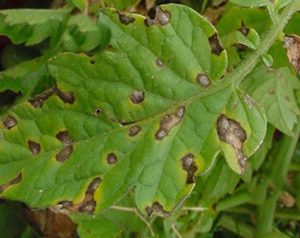
Hybrid "Spassky Tower F1", like many hybrids, is resistant to most fungal diseases. However, despite the resistance to temperature extremes and some shading, it still needs preventive protection. When the threat of late blight appears, the plants are treated with phytosporin or other drugs.
With the observance of the rules of crop rotation and pre-sowing liming of the soil, the mass occurrence of pests on tomatoes is usually not observed. However, slugs are sometimes found in greenhouses, and in early spring the Colorado beetles love to feast on delicate leaves of tomatoes.To protect plants, it is sometimes enough to inspect and remove them manually.
This tomato appeared on the market only in 2015, but its unique qualities - taste, resistance to temperature and shading, high yields have already interested many vegetable growers - amateurs.
Video: Pomidors at greenhouse in real life


 (9 ratings, average: 4,00 from 5)
(9 ratings, average: 4,00 from 5)